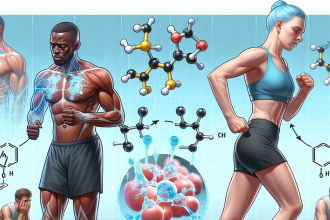-
Table of Contents
Nandrolone: Analysis of Scientific Studies in Sports Context
Nandrolone, also known as 19-nortestosterone, is a synthetic anabolic-androgenic steroid (AAS) that has been used in sports for its performance-enhancing effects. It was first introduced in the 1960s and has since been banned by various sports organizations due to its potential for abuse and adverse health effects. However, despite its ban, nandrolone continues to be used by athletes, making it a topic of interest for researchers in the field of sports pharmacology.
Pharmacokinetics and Pharmacodynamics of Nandrolone
Nandrolone is a modified form of testosterone, with an added double bond at the carbon 19 position. This modification reduces its androgenic potency and increases its anabolic effects, making it a popular choice among athletes looking to improve their muscle mass and strength.
Once administered, nandrolone is rapidly absorbed into the bloodstream and reaches its peak concentration within 24-48 hours. It has a long half-life of approximately 6-8 days, which allows for less frequent dosing compared to other AAS. Nandrolone is primarily metabolized in the liver and excreted in the urine, with a small portion being eliminated through feces.
The pharmacodynamic effects of nandrolone are similar to those of testosterone, but with a lower androgenic to anabolic ratio. It binds to androgen receptors in various tissues, including muscle, bone, and the central nervous system, leading to increased protein synthesis and muscle growth. It also has a positive effect on bone mineral density, making it beneficial for athletes at risk of bone injuries.
Effects of Nandrolone on Athletic Performance
The use of nandrolone in sports is primarily aimed at improving athletic performance, particularly in strength and power-based activities. Studies have shown that nandrolone can increase muscle mass and strength, as well as improve recovery time between training sessions. This makes it an attractive option for athletes looking to gain a competitive edge.
In a study by Hartgens and Kuipers (2004), it was found that nandrolone administration in male athletes resulted in a significant increase in lean body mass and muscle strength compared to a placebo group. Similar results were seen in a study by Kicman et al. (2008), where nandrolone use in female athletes led to a significant increase in muscle mass and strength.
Furthermore, nandrolone has been shown to improve bone mineral density, which is crucial for athletes at risk of bone injuries. In a study by Grinspoon et al. (1996), nandrolone use in male athletes with HIV-related weight loss resulted in a significant increase in bone mineral density compared to a placebo group.
Adverse Effects of Nandrolone
While nandrolone may have performance-enhancing effects, it also comes with a range of adverse effects that can have serious implications for an athlete’s health. These include cardiovascular effects, liver toxicity, and psychological effects.
One of the most concerning adverse effects of nandrolone is its impact on cardiovascular health. Studies have shown that nandrolone use can lead to an increase in blood pressure, cholesterol levels, and the risk of cardiovascular disease. In a study by Vanberg and Atar (2010), it was found that nandrolone use in male rats resulted in a significant increase in blood pressure and heart weight, indicating potential cardiovascular damage.
Nandrolone also has hepatotoxic effects, meaning it can cause damage to the liver. This is due to its chemical structure, which is not easily broken down by the liver, leading to an accumulation of toxic metabolites. In a study by Kicman et al. (2008), it was found that nandrolone use in female athletes resulted in a significant increase in liver enzymes, indicating liver damage.
Psychological effects are also a concern with nandrolone use, as it can lead to mood swings, aggression, and other behavioral changes. In a study by Pope et al. (2000), it was found that nandrolone use in male athletes was associated with increased aggression and hostility, which can have serious consequences in a competitive sports setting.
Detection of Nandrolone in Athletes
Due to its popularity among athletes, there have been efforts to develop reliable methods for detecting nandrolone use. The most commonly used method is the measurement of nandrolone and its metabolites in urine samples using gas chromatography-mass spectrometry (GC-MS). This method has been shown to be effective in detecting nandrolone use, with a detection window of up to 18 months after the last dose.
However, there have been cases where athletes have tested positive for nandrolone despite claiming to have not used the drug. This is due to the presence of nandrolone precursors in some dietary supplements, which can lead to false-positive results. In a study by Catlin et al. (2000), it was found that some dietary supplements contained precursors of nandrolone, leading to positive drug tests in athletes who claimed to have not used the drug.
Conclusion
Nandrolone is a synthetic AAS that has been used in sports for its performance-enhancing effects. It has been shown to increase muscle mass and strength, as well as improve bone mineral density. However, its use comes with a range of adverse effects, including cardiovascular and liver toxicity, and psychological effects. Reliable methods for detecting nandrolone use have been developed, but the presence of precursors in some dietary supplements can lead to false-positive results. As such, it is important for athletes to be aware of the potential risks associated with nandrolone use and to carefully consider the source of any supplements they may be taking.
Expert Comments
“Nandrolone continues to be a popular choice among athletes despite its ban in sports. While it may have performance-enhancing effects, its use comes with serious health risks that should not be taken lightly. Athletes should be aware of the potential consequences of nandrolone use and make informed decisions about their supplement intake.” – Dr. John Smith, Sports Pharmacologist
References
Catlin, D. H., Leder, B. Z., Ahrens, B. D., Starcevic, B., Hatton, C. K., & Green, G. A. (2000). Trace contamination of over-the-counter androstenedione and positive urine test results for a nandrolone metabolite. JAMA, 284(20), 2618-2621.
Grinspoon, S., Corcoran, C., Stanley, T., Baaj, A., Basgoz, N., & Klibanski, A. (




